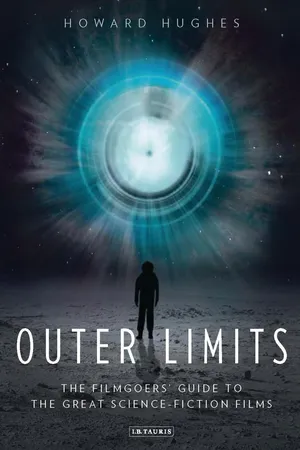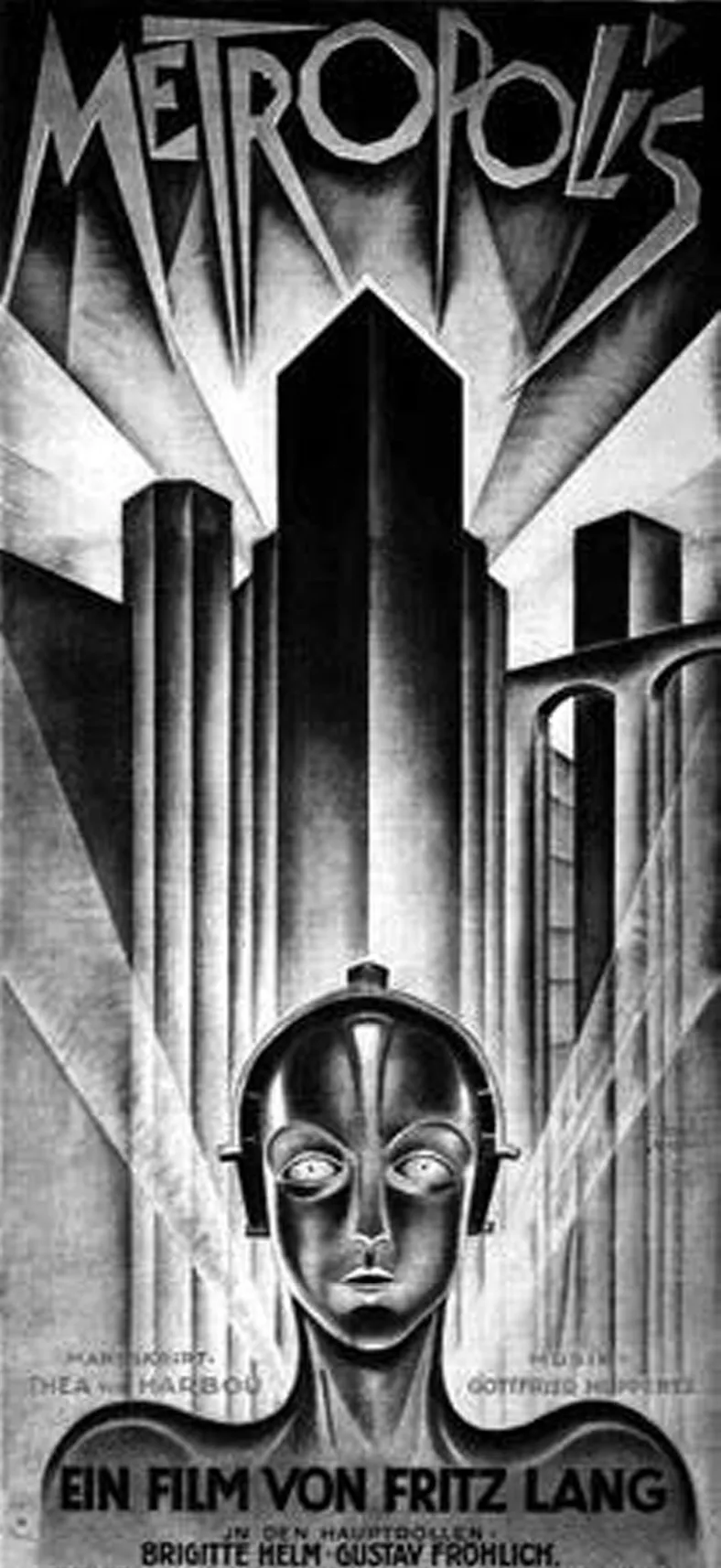1
‘Death to the Machines’
METROPOLIS (1927)
Director: Fritz Lang
Producer: Erich Pommer
Story: Thea von Harbou
Screenplay: Thea von Harbou and Fritz Lang
Directors of Photography: Karl Freund, Günther Rittau and Walter Ruttmann
Music: Gottfried Huppertz (1927; Ufa German premiere)
A Universum Film AG (Ufa) Production
Released by Parufamet
119 minutes
Alfred Abel (Joh Fredersen, master of Metropolis), Gustav Fröhlich (Freder, Joh’s son), Rudolf Klein-Rogge (C.A. Rotwang, inventor), Fritz Rasp (the Thin Man, Joh’s spy), Theodor Loos (Josaphat), Erwin Biswanger (worker No. 11811), Heinrich George (Grot, chief foreman of the Heart Machine), Brigitte Helm (Maria and Machine Man Maria), Hanns Leo Reich (Marinus), Fritz Alberti (creative human who conceives Babel), Georg John (worker who causes explosion of M-Machine)
* * *
The first truly great work of science fiction cinema was Metropolis. In 1927 the silent era was almost at an end – the first talkie, The Jazz Singer was released that same year – when Fritz Lang directed his epic. Lang married actress and author Thea von Harbou in 1922. They divorced in 1933 (when she joined the Nazi Party and he fled the country), but during their marriage they collaborated on the script for Metropolis. Von Harbou’s source novel, also called Metropolis, first appeared in the magazine Das Illustrierte Blatt in Frankfurt in 1925, and a book version was published shortly before the film’s release.
The futuristic city of Metropolis is one of chasmic class divides. Below ground, workers toil in their subterranean city, ensuring the well-oiled wheels of Metropolis turn and its pistons pump. Above ground, the rich and privileged enjoy the luxurious delights of the Eternal Gardens or the bacchanalian ‘entertainment district’ of Yoshiwara. The master of Metropolis is Joh Fredersen (Alfred Abel). Freder (Gustav Fröhlich), his son, rejects his father’s class when he encounters Maria (Brigitte Helm), a nanny to the workers’ children. Fascinated by Maria’s simple, pure beauty, Freder descends into the city’s bowels to seek her out. He becomes a factory labourer, trading identities with worker No. 11811, and is eventually invited to a meeting in the 2,000-year-old catacombs below Metropolis. There he finds Maria preaching to the workers the legend of the Tower of Babel (an allegory of their toil for Joh in Metropolis) and assures them that the hour of their deliverance is at hand via a ‘mediator’. Joh and inventor Rotwang spy on the workers and resolve to destroy the workers’ faith in Maria. They substitute Maria with Rotwang’s latest project – a robotic ‘machine man’. As Joh instructs: ‘I want you to visit those in the depths, in order to destroy the work of the woman in whose image you were created.’ Their robot, the living image of Maria, sows discord among the workers, while the real Maria is locked away. But the inventor plans to destroy both the rich man and his son, as Rotwang has programmed Maria to obey only his will.
Metropolis was shot at Babelsberg Studios. It took 16 months to film, in 1925–26, with a cast of over 37,000, on gargantuan sets. At the equivalent of over $200 million, it is still both the most expensive silent film and the most expensive German film ever lensed. Brigitte Helm was excellently cast as both the serene Maria and her crazy-eyed evil twin, the ‘Machine Man Maria’, who inspires frenzied lust with her near-naked erotic dances for the rich sinners in Yoshiwara and incites the proletariat in the workers’ city to destroy the machines. She says they are ‘living food for the machines in Metropolis’ which lubricate ‘the machine joints with their own blood’. Fritz Rasp played Joh’s shadowy spy, the Thin Man, but most influential was Rudolf Klein-Rogge (from Lang’s Dr Mabuse films) as the madcap inventor, Rotwang, with his wild hair and artificial hand. His creation, the Machine Man, remains an iconic sci-fi creation. The sequence of the Machine Man coming to life, encircled in throbbing hoops of electronic energy, is among the most resonant in futurist cinema.
Metropolis: German poster art for Fritz Lang’s silent sci-fi epic speaks volumes for the film’s stylised, futuristic production design.
Metropolis’s cityscape is a fantastical architectural creation. Some sources date the film’s setting as around AD 2000, though this is not specified in the film. The art direction and set design was by Otto Hunte, Erich Kettelhut and Karl Vollbrecht, with sculptures by Walter Schultze-Mittendorf. The special-effects shots were conceived and staged by Ernst Kunstmann and Eugen Schüfftan (anglicised to Eugene Shuftan in the US). Schüfftan was the progenitor of the Schüfftan process, which comprised an angled composite shot that combined miniatures and background scenery, with actors in the foreground. The process was later overtaken by matte shots. In Metropolis, cars clog the broad streets and biplanes fly between the towering buildings. There are metro-train monorails and highways in the sky. Lang was inspired by his impression of the Manhattan skyline in October 1924, when he visited the US to observe Hollywood filmmaking techniques. Metropolis is a living, breathing city, with a heart and lungs – the phalanx of workers is its lifeblood. The Machine Halls are vivid powerhouses of steel and steam. Rotwang’s bubbling laboratory and Machine Man’s rebirth as Maria influenced the equivalent scenes in Hollywood’s sci-fi horror Frankenstein (1931). The catacombs are recreated in great detail, with burial chambers, skulls and skeletons, as is the grim statuary of the cathedral. The Eternal Gardens, an earthly Eden, is strewn with exotica – flora and fauna, graceful birds and ornate fountains – amongst which the rich elitists idly flit. The stylised look of the film displays the influence of German expressionism (as epitomised by The Cabinet of Dr Caligari [1920]), but is also a haunting vision of future science fiction from cinema now long past.
Lang’s workers plot insurrection in the City of the Dead catacombs, while the indolent rich carry on regardless. The shuffling workers are drones, who advance rank on rank like automatons. They are replaced by the next shift, which piles into the city’s vast elevators, ensuring the machines never sleep. There are also references to classical mythology and the Bible. In the cavernous machine halls, Freder imagines the M-Machine as the hideous, gaping-mouthed god Moloch, with the workers as sacrificial victims, while another scene recreates the construction of the Tower of Babel. The workers cry ‘Death to the machines’, storm the Machine Hall and overload the Heart Machine (in some prints called the Central Dynamo). The Vegas-style lights flicker out, industry comes to a standstill, escalators plummet and smash, and the workers’ city is engulfed in a rushing flood of biblical proportions. Maria and Freder save the workers’ children from the flood, eventually taking them to the Club of the Sons. The workers seek out the ‘witch’ they think is responsible for their children’s deaths and burn Robot Maria at the stake outside the cathedral, while Rotwang chases Maria through the cathedral, where the daredevil bell-swinging seems inspired by The Hunchback of Notre-Dame. Society’s class divides are depicted straightforwardly and the story’s mantra ‘The mediator between head and hands must be the heart’ is visualised in the denouement. A V-shaped phalanx of workers led by burly Grot (Heinrich George) approach the cathedral. The ‘Mediator’ (Freder) unites labour (Grot) with financial capital (Joh). Unlike Sergei Eisenstein’s montages of worker revolution, Lang’s film proffers peaceful resolution.
Metropolis bombed in Germany on its release early in 1927 and brought Ufa close to bankruptcy. It was saved by Alfred Hugenberg, one of Adolf Hitler’s financial backers. Was Lang thinking about the political situation in Weimar Germany and the rise of Fascism when he made Metropolis? Mein Kampf was published shortly before Lang shot his film and the workers are galvanised by Robot Maria, a wild-eyed zealot with big ideas. When the Nazis came to power in Germany in 1933, Hitler and his henchmen invited Lang to be their propaganda filmmaker. Lang, worried about his ancestry (his mother had a Jewish background) headed for the US, via France and Britain, where he continued to make films, only returning to Germany at the end of his career in the late 1950s.
Metropolis exists in many different prints, of varying quality and length, some as short as 75 minutes. The best versions are the 119-minute German print (prepared by the Murnau Foundation in 2002) and a US public domain version, running 118 minutes. All that survives of Lang’s masterpiece are ‘incomplete original negatives’ and ‘copies of shortened and re-edited release prints’. The 119-minute version recreates the 1927 German film premiere version, via all available materials, ‘based on the version in the Filmmuseum Munich and material preserved in the Bundesarchiv-Filmarchiv’. The images have been restored and additional intertitles describe what is still missing from the plot – this mainly includes the Thin Man keeping Freder under observation, Josaphat (Joh’s assistant) and the workers. Gottfried Huppertz’s original score was reconstructed and conducted by Berndt Heller, and performed by the Rundfunk-Sinfonieorchester Saarbrücken. The film is structured in three sections: the Prelude (until Maria is imprisoned by Rotwang), the Intermezzo (as Freder hallucinates that the Grim Reaper comes to life and ‘Death descends upon the city’) and the Furiosi (the film’s finale, including the workers’ revolt and the destruction of the city).
The US print anglicises several names (Joh becomes John, Josaphat Joseph) and is missing several sequences, including athletes sprinting in a grand stadium and all reference to Joh’s deceased wife Hel, who died giving birth to Freder. The US print begins with a quote from von Harbou, stating: ‘This film is not of today or of the future. It tells of no place. It serves no tendency, party or class.’ A 1984 reissue at 87 minutes included colour tints and a score by Giorgio Moroder (featuring songs by such artists as Freddie Mercury, Pat Benatar, Bonnie Tyler and Adam Ant). Footage from Metropolis also appeared in Queen’s promo for their single ‘Radio Ga Ga’. Following the discovery of an unexpurgated print, the monumental 2010 reconstruction of Metropolis has extended the film, with much footage previously thought lost, to 153 minutes.
Metropolis is the name of the city setting in Superman, and Lang’s film inspired a Japanese anime, also called Metropolis, which was directed by Rintaro in 2001. The people of Metropolis celebrate the opening of the Ziggurat, a Tower of Babel that looms over the futuristic city, which is rumoured to harbour a powerful secret weapon or a military facility. President Boone rules the city, but the Marduk Party led by Duke Red covet power. Duke Red has renegade scientist Dr Laughton create a blonde robot woman, Tima. Detective Shunsaku Ban arrives from Japan in search of the doctor, who has international warrants standing for his arrest. With help from his nephew Kenichi and friendly robot bodyguard Pero, he scours the city. An attempted coup d’état by revolutionaries led by Atlas is suppressed by the Marduks, and Duke R...

